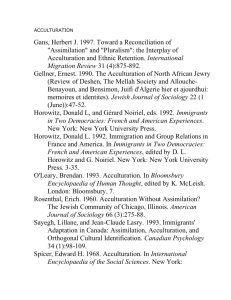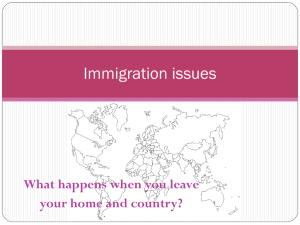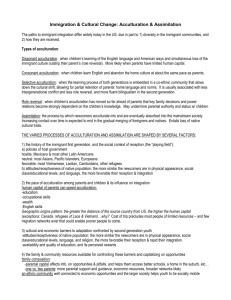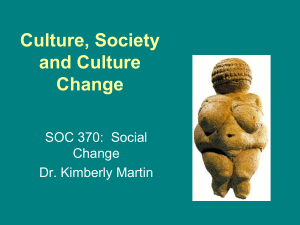7th Social Studies Genetics and Bioengineering
advertisement
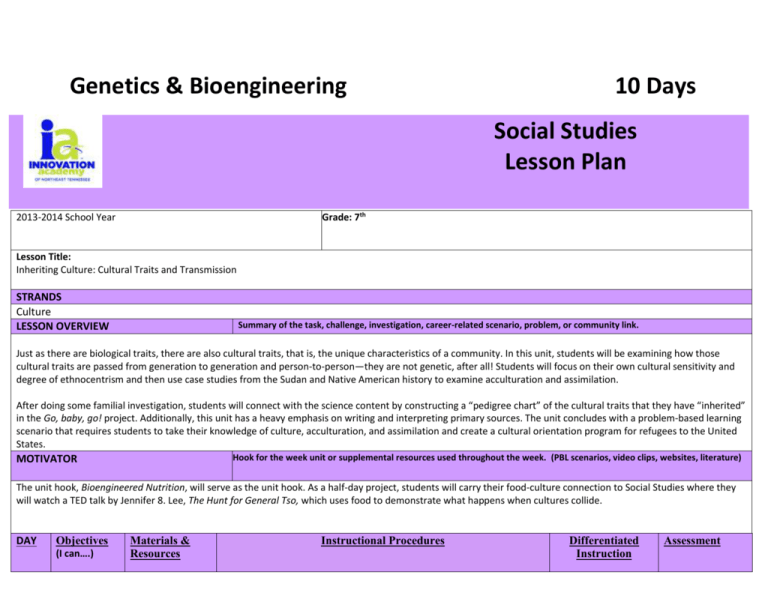
Genetics & Bioengineering 10 Days Social Studies Lesson Plan Grade: 7th 2013-2014 School Year Lesson Title: Inheriting Culture: Cultural Traits and Transmission STRANDS Culture LESSON OVERVIEW Summary of the task, challenge, investigation, career-related scenario, problem, or community link. Just as there are biological traits, there are also cultural traits, that is, the unique characteristics of a community. In this unit, students will be examining how those cultural traits are passed from generation to generation and person-to-person—they are not genetic, after all! Students will focus on their own cultural sensitivity and degree of ethnocentrism and then use case studies from the Sudan and Native American history to examine acculturation and assimilation. After doing some familial investigation, students will connect with the science content by constructing a “pedigree chart” of the cultural traits that they have “inherited” in the Go, baby, go! project. Additionally, this unit has a heavy emphasis on writing and interpreting primary sources. The unit concludes with a problem-based learning scenario that requires students to take their knowledge of culture, acculturation, and assimilation and create a cultural orientation program for refugees to the United States. Hook for the week unit or supplemental resources used throughout the week. (PBL scenarios, video clips, websites, literature) MOTIVATOR The unit hook, Bioengineered Nutrition, will serve as the unit hook. As a half-day project, students will carry their food-culture connection to Social Studies where they will watch a TED talk by Jennifer 8. Lee, The Hunt for General Tso, which uses food to demonstrate what happens when cultures collide. DAY Objectives (I can….) Materials & Resources Instructional Procedures Differentiated Instruction Assessment 1 I CAN describe cultural adaptations demonstrated in foodways. iPad Video: The Hunt for General Tso (Appendix A) Apple TV or Projection System Essential Questions: How does culture influence food and food influence culture? Enrichment Formative Project Half Day – Refer to Unit Plan Heterogeneous grouping Peer Tutoring Online Activity: The Meaning of Food Bioengineered Nutrition Summative Remediation I. Set: a. Discuss/debrief with students the Bioengineered Nutrition activity. Pay particular attention to the cultural ties to each student-created imaginary produce item. II. Teaching Strategy a. Explain to students that just as there are biological traits that are passed along from generation to generation, so too are there cultural traits that are passed from person to person. b. Play Jennifer 8. Lee’s video, The Hunt for General Tso. III. Summarizing Strategy: a. Review some of the key concepts presented in the video and then review the below follow up questions for students to answer for homework: i. How does a food item/cuisine (e.g. the fortune cookie) morph into something that is barely recognizable by the cultural group it is meant to originate from? Classroom discussion Video response questions Heterogeneous grouping Peer Tutoring Extended time on assignments for selected students Check often for understanding of subject matter Students will demonstrate their mastery of the content in the problem-based learning scenario Cultural Orientation. ii. "These people who eat foods different than us must be different than us." This quote is referring to a fundamental difference on the human level, not just culturally. This mentality has been grounds for excluding a cultural group or ethnicity within culture. Respond with your own reaction to this quote. iii. Can you think of another example of a cuisine (other than "Chinese") that has morphed as a result of outside cultural influence? Explain your answer. 2 I CAN describe ethnocentrism and cite examples of ethnocentric points of view. Socrative.com iPad Apple TV or projection system. Doceri App or other whiteboard app. “Assessing Your Ethnocentrism ” (Appendix A) Essential Question: How does my own culture shape how I view other cultures? I. II. Set: a. Explain to students that all people form judgments of another culture (to varying degrees). b. Using the short answer function of Socrative.com, ask students to submit one opinion of a behavior or belief of a culture that is different than their own. Remind students to keep their language and viewpoints school appropriate. c. Display student responses for the class to view. Teaching Strategy: a. Explain to students that an important aspect of learning about other cultures is to understand one’s own ethnocentric biases. b. Write the word “ethnocentric” on the board/whiteboard app and divide the word in half (e.g. “ethno|centric). c. Ask students to brainstorm a list of words they know that may be related to one of the two halves of “ethnocentric” Enrichment Formative Heterogeneous grouping Peer Tutoring Remediation Heterogeneous grouping Peer Tutoring Extended time on assignments for selected students Check often for understanding of subject matter Classroom discussion Student observation Exit ticket Summative Students will demonstrate their mastery of the content in the problem-based learning scenario Cultural Orientation. (i.e. “ethnic” and “center”). d. Define ethnocentrism (the tendency to use one’s own cultural standards and values to judge the behaviors and beliefs of people with different cultures.) and refer back to the anticipatory set for examples. e. Discuss with students that we are all ethnocentric to some degree and that by being aware of our own biases, we can then be more objective in our views towards other cultures. f. Allow students time to take McCroskey and Neuliep’s “Assessing Your Ethnocentrism” quiz. III. Summarizing Strategy: a. Allow students time to score their ethnocentrism assessment and then discuss the results with a partner. b. Using the exit ticket function of Socrative.com, ask students to reflect upon the results of their assessment. Were you surprised by the results of your ethnocentrism assessment? Why or why not? 3 I CAN compare and contrast acculturation Socrative.com iPad Digital notebooks Essential Question: How is culture changed through acculturation? How is culture changed through assimilation? Enrichment Formative Heterogeneous grouping Class discussion and assimilation. Smithsonian Folklife and Oral History Interviewing Guide (pages 23-27) (Appendix A) Cultural Traits Interview (Appendix B) I. Set: a. Using the short-answer function of Socrative.com, have students reply to the following: Yesterday, we discussed ethnocentrism. Please describe ethnocentrism in your own terms and give an example of ethnocentrism you have encountered (or exhibited!) II. Teaching Strategy: a. Review with students the concept of cultural diffusion (from previous unit). b. Introduce the concepts of acculturation (the process of adopting the traits of a cultural group) and assimilation (process by which people acquire the culture and habits of the dominant group with no characteristics of the minority group remaining). These should be included in students’ digital notebooks. c. Provide three stations around the room through which students will rotate, working in collaborative groups of two or three. The stations will be designated: Skit, Drawing, Research d. Skit: Students will write a brief skit demonstrating either assimilation of acculturation. e. Drawing: Students will create a drawing that demonstrates either acculturation or assimilation. f. Research: Students find a real-life case study that demonstrates either acculturation or assimilation. g. Require students to choose to at least two of the three stations, allowing approximately 15 minutes at each. III. Summarizing Strategy Peer Tutoring Stations: Skit, Drawing, Advanced learners Research may incorporate both elements of acculturation and assimilation in one Summative drawing/skit/rese Students will arch. demonstrate their mastery Remediation of the content in the Shorter articles problem-based may be assigned learning to scenario developing/strugg Cultural ling readers. Orientation. Heterogeneous grouping Peer Tutoring Extended time on assignments for selected students Check often for understanding of subject matter Student Choice: students choose which stations they visit. a. Regroup the class as a whole and allow time for students to share their skits, drawings, or case studies (one per team). b. Introduce students to the Cultural Interview Assignment and accompanying interview guide. This information will be used for the project day on day 8. 4 I CAN describe acculturation via a real-life scenario. Socrative.com iPad Reading: The History of the Lost Boys of the Sudan Video: The Lost Boys of Sudan (Appendix A) Acculturation: The Lost Boys of Sudan Assignment (Appendix B) Essential Question: How do the Lost Boys of the Sudan exemplify acculturation? I. II. Set: a. Using the short-answer function of Socrative.com, have students write and submit their own definition for acculturation. Teaching Strategy: a. Explain to students that they will be examining a real life scenario that exemplifies acculturation. b. Reading strategy: Stump the Teacher Instruct students to begin reading the background information regarding the Lost Boys of Sudan. Make your reading of the text evident to students. Once all students have finished reading, allow them two minutes to ask you contextual questions about the text. After two minutes is up, give students two minutes to answer questions asked by the teacher. Enrichment Formative Heterogeneous grouping Peer Tutoring Remediation Heterogeneous grouping Peer Tutoring Check often for understanding of subject matter The reading text may be chunked into smaller sections for increased comprehension Student observation Stump the Teacher Acculturation: The Lost Boys of Sudan Assignment Exit Ticket Summative Students will demonstrate their mastery of the content in the problem-based c. Play the Lost Boys of the Sudan video, pausing after crucial points or to clarify misconceptions raised by students. d. Allow students time in class to begin the Acculturation: The Lost Boys of Sudan Assignment. III. (simply play additional rounds of “Stump the Teacher”) learning scenario Cultural Orientation. Summarizing Strategy: a. Using the exit ticket function on Socrative.com, ask students to formulate an answer to the essential question of the day. Essential Question: 5 Project Day – Refer to Unit Plan Guest Speaker Day 6 I CAN draw conclusions about assimilation from primary sources. iPad Assimilation: Indian Boarding Schools Assignment (Appendix A) Essential Question: How do the Native American Indian boarding schools exemplify assimilation? Enrichment Formative This lesson was adapted from a Library of Congress Teacher Resource. I. Set: a. Ask students: Are you civilized? b. Facilitate a classroom conversation addressing this question. Students should incorporate their own understandings of ethnocentrism, acculturation, and assimilation. Heterogeneous grouping Peer Tutoring Advanced students may not require the guiding questions that accompany the primary Student observation Stump the Teacher Assimilation: Indian Boarding Schools Assignment II. III. Teaching Strategy a. Explain that the question of “What is civilized?” has been asked and answered by humankind all around the world throughout time. b. Specifically, in American history this question was asked with regard to the Native American Indians. Explain that one such (ethnocentric) solution by the American government in the 19th and 20th centuries was to establish Indian boarding schools. Pose the essential question to students. c. Talk students through the Indian Boarding Schools assignment sheet, providing them with the Library of Congress Indian Boarding Schools Galleries: Appearances, Dwellings, Daily Life and Customs. d. Depending on student experience with primary source analysis, coaching or individualized instruction using the primary source analysis tool may be necessary. Summarizing Strategy a. Allow students to airplay their galleries of selected images demonstrating the assimilation of Indian culture. Discuss the shift that occurred from Native culture to a more “civilized”. b. Direct students to the Library of Congress Indian Boarding School Journal Resources. c. For homework, students are to select one person or group of people and read the related primary source excerpts. Additionally, they should conduct research using reliable resources to learn more about the individual(s) selected. source analysis tool. Student gallery Remediation Summative Heterogeneous grouping Peer Tutoring Check often for understanding of subject matter The guiding questions accompanying the primary source analysis tool will help guide students in their analysis of primary source photographs. Students will demonstrate their mastery of the content in the problem-based learning scenario Cultural Orientation. 7 I CAN draw conclusions about assimilation from primary sources. Socrative.com Essential Question: How do the Native American Indian boarding schools exemplify assimilation? iPad Online discussion This lesson was adapted from a Library of Congress Teacher Resource. forum (via a I. Set: learning a. Using the short-answer function of Socrative.com, instruct management student to respond to the following statement: system such as Moodle, Indian children should have attended Indian boarding Canvas, or schools so that they could be more civilized. CourseSites). II. Teaching Strategy a. Explain to students that they will be participating in and 19th/20th century discussion forum. Students are to assume the role of the historical figure they researched for homework on day six. To enhance the activity, identify the figure each student selected and only refer to students by that historical name. b. Give students approximately ten to fifteen minutes to write an initial post in the discussion forum, responding to the following prompt in character: Indian children should attend Indian boarding schools so that they may be more civilized. c. After the time period of writing the initial response to the prompt, allow students ten to fifteen additional minutes to respond to a historical figure different than their own. Instruct them to try to think and act as their assumed identity would have during the given time period. d. The writing rounds may be repeated as many times as the class period allows or until students begin to run out of Enrichment Formative Heterogeneous grouping Peer Tutoring Remediation Heterogeneous grouping Peer Tutoring Extended time on assignments for selected students Check often for understanding of subject Informal questioning Electronic notebook entries Summative Students will demonstrate their mastery of the content in the problem-based learning scenario Cultural Orientation. people to respond to. ***This activity may also be completed on paper with students simply exchanging papers and journaling back and forth to one another on paper. *** III. Summarizing Strategy: a. In their electronic notebooks, ask students to reflect: Through the completion of this activity, have your ideas of what it means to be civilized changed? What are your opinions regarding the treatment of Native American Indians by the non-natives? Can you think of related examples either from history or today? Essential Question: 8 Project Day – Refer to Unit Plan Go, Baby, Go! 9 I CAN identify and compare the cultural traits of my culture and iPad Apple TV or Projection System Faces of Essential Question: How would I prepare a refugee for their cultural transition to the United States? I. Set: Remediation Formative Heterogeneous grouping Peer Tutoring Student observation and another. Resettlement (0:00-3:10) Appendix A Office of Refugee Resettlement’ s 2011 Report to Congress Mind Map software such as bubbl.us. Problembased scenario grading rubric (Appendix B) a. Using the short-answer function on Socrative.com, have students respond to the following: Imagine being plucked from your homeland, the United States, and dropped into a brand new culture that you have never encountered before. How would you feel? What would you need to know? b. Play the three-minute excerpt of Faces of Resettlement. c. Provide students with the following information: You have just accepted a position with the United State’s Office for Refugee Resettlement. As part of your new position, you have been charged with the task of writing cultural orientation programs for some of the prominent refugee groups entering the United States. How will you prepare the refugees for their cultural transition to the United States? Extended time on assignments for selected students Check often for understanding of subject Individualized instruction Students may require examples of real-life cultural orientation materials, available through the office of Refugee Resettlement. Enrichment II. Teaching Strategy a. Present students with data from the Office of Refugee Resettlement’s 2011 Report to Congress: - - Burma remained the largest country of origin among refugee arrivals between 2006 and 2011. The next largest was Iraq, Bhutan, Somalia, then Iran. Arrivals from Cuba comprised the largest group in 2011 alone. During 2006 to 2011, however, there were 102 countries represented by the refugee population in the United States. b. Allow students to work in collaborative groups of two or three on this problem-based learning scenario. c. After student groups are selected, they will need to select Depending on the level of depth, this assignment may be extended to allow students to investigate further, address multiple refugee populations, or derive more complex solutions. conferencing. Summative Students will demonstrate their mastery of the content in the problem-based learning scenario Cultural Orientation. a refugee population with which to work (use prominent countries from ORR report above). d. In order to leave the assignment open-ended, allowing for multiple products or artifacts to be created (yet still keeping students focused) conduct a brainstorming session using a bubbl.us mind map. Brainstorm the two questions below with students, displaying responses as they work: - What are some potential formats of your cultural orientation? What do I need to know in order to design a successful cultural orientation? e. Give students the remainder of the period to derive a solution to the problem. Monitor student progress and serve as a coach. Students should focus solely on the planning of the cultural orientation with the construction/creation reserved for day 10. III. 10 I CAN identify and compare iPad Apple TV or Summarizing Strategy: a. Conference with each group to monitor their progress, provide guidance, and assess whether additional planning time may be needed. Essential Question: How would I prepare a refugee for their cultural transition to the United States? Remediation Formative the cultural traits of my culture and another. Projection System Mind Map software such as bubbl.us. (Including map from previous day) Problembased scenario grading rubric (Appendix B) I. II. III. Set: a. Allow student groups to brief the other student groups on their approach and progress to the problem. Allow students to give one another feedback. Instructional Strategy: a. Students will use the class period to carry out their plans for their cultural orientation. b. If additional class time is needed, this PBL scenario may be extended into a third day. Summarizing Strategy: a. Host a gallery walk for students to display their own work and view one another’s work. Heterogeneous grouping Peer Tutoring Extended time on assignments for selected students Check often for understanding of subject Individualized instruction Students may require examples of real-life cultural orientation materials, available through the office of Refugee Resettlement. Enrichment Depending on the level of depth, this assignment may be extended to allow students to investigate further, address multiple refugee populations, or derive more complex solutions. Student observation and conferencing. Summative Students will demonstrate their mastery of the content in the problem-based learning scenario Cultural Orientation. STANDARDS Identify what you want to teach. Reference State, Common Core, ACT College Readiness Standards and/or State Competencies. Grade Level Expectations 1.01 Understand the nature and complexity of culture. 1.03 Identify the role those diverse cultures had on the development of the Americas. Student Performance Indicators 7.1.spi.1. Recognize cultural definitions (i.e., language, religion, customs, political system, economic system). 7.1.spi.2. Locate cultural information on a thematic map (i.e., languages, political systems, economic systems, religions).
